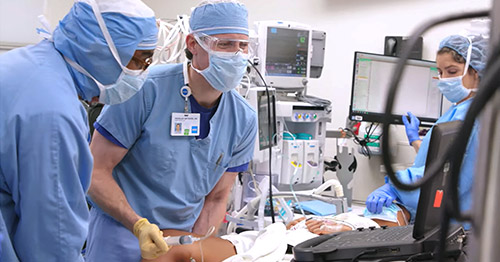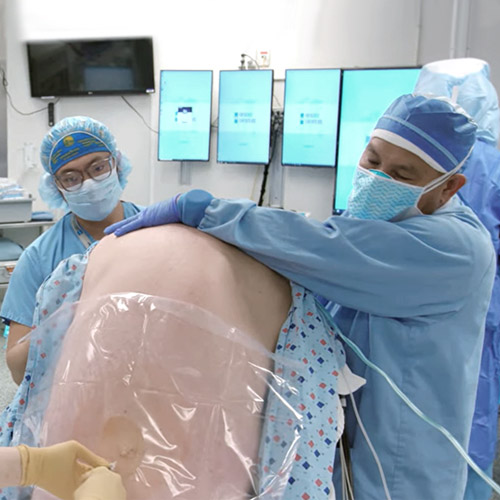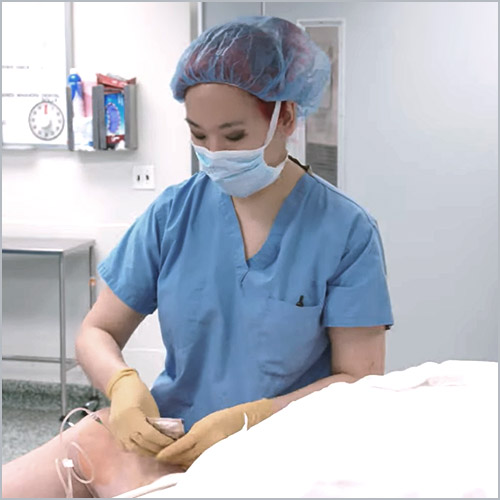Anesthesia During Hip or Knee Replacement: What to Expect During and After Surgery

Anesthesiologists at Hospital for Special Surgery work very closely with the orthopedic surgeons and entire perioperative team to ensure the safest and most comfortable experience for our patients undergoing joint replacement surgery.
There are multiple options available for anesthesia, but we tailor the type of anesthesia specifically for each patient to account for their pre-existing medical conditions, medical history, previous anesthetic experiences, type of surgery and post-operative recovery. This article discusses the types of anesthesia you may receive and explains your anesthesiology experience before, during and after surgery.
Preoperative discussion with your anesthesiologist
Generally, you will meet your anesthesiologist on the day of surgery in the preoperative holding area to discuss your anesthetic plan and address any specific questions or concerns you may have. During this preoperative evaluation, your anesthesiologist will review your medical history and medications with you, ensure that you have fasted for the appropriate time before surgery, and present the anesthetic plan to you for both the operating room and the recovery period following surgery.
To help facilitate your overall recovery and minimize your pain after surgery, your anesthesiologist will perform peripheral nerve blocks in the operating room. You may take this opportunity to ask questions and express any concerns you may have.
An intravenous (IV) line will be placed in the holding area. The anesthesiologist will use the IV line to administer sedation once you arrive in the operating room. The sedative will relieve your anxiety and make you comfortable while the anesthesia monitors are being applied. Additional sedation will be administered appropriately to allow the anesthesiologist to perform the planned procedures while keeping you comfortable and safe. Sedation will continue during the operation to ensure that you remain unconscious and breathing well.
In some cases, your surgeon or internist may refer you to speak with one of our anesthesiologists or nurse practitioners prior to your surgery to address any medical issues or concerns in advance.
How is the risk of postoperative nausea and vomiting reduced?
Postoperative nausea and vomiting (PONV) is a common concern for patients undergoing surgical procedures. The causes of PONV are numerous and include the type of anesthesia used, opioids, type of surgery, and patient factors. By using regional anesthesia for your surgery, we can avoid many of the causes of PONV such as general anesthesia and opioids in the operating room. We also administer several classes of anti-nausea medications to minimize the risk of nausea postoperatively. Additional anti-nausea medication can be administered postoperatively if you are experiencing any symptoms of nausea or vomiting.
Spinal versus general anesthesia: What is the best option for total hip or knee replacement?
The two main types of anesthesia used for hip replacement or knee replacement surgery are regional anesthesia and general anesthesia. At Hospital for Special Surgery, greater than 90% of hip and knee joint replacement surgeries are performed under regional anesthesia, which includes both spinal and epidural anesthesia.
Regional anesthesia is a safe and effective technique that allows you to avoid general anesthesia. This usually leads to a smoother recovery, often with less grogginess, reduced nausea/vomiting, decreased blood loss during the surgery and decreased risk for deep vein thrombosis postoperatively compared to general anesthesia.
It’s important to know that patients who receive regional anesthesia will be unconscious and breathing spontaneously during surgery. This is different from patients who receive general anesthesia where airway instrumentation or intubation and mechanical ventilation are required.
However, not all patients are candidates for regional anesthesia. Some reasons why patients might not receive regional anesthesia (called “contraindications”) include:
- allergy to local anesthetics
- certain neurologic conditions
- spine surgery (depending on symptoms, extent of surgery, presence of hardware, etc.)
- certain heart conditions
- bleeding disorders, recent use of blood thinners, and/or abnormal laboratory values
- active infection
- other reasons that can be further discussed with your anesthesiologist
What is the difference between spinal and epidural anesthesia?
This can be confusing to many patients. Both methods involve the injection of medication into or near the spinal cord. The key differences are the specific location of the injection site, the speed in which the anesthetic spreads throughout the body, and the length of time during which they are effective.
In spinal anesthesia, the local anesthetic is injected in the lumbar spine, into the cerebrospinal fluid within the spinal canal. This spreads quickly to the spinal nerves and provides a fast onset of sensory and motor block, meaning that sensations/pain and movement will both be blocked.

Spinal anesthesia being applied in preparation for orthopedic surgery.
In epidural anesthesia, the local anesthetic is delivered into the epidural space that lies within the spinal canal, but outside the protective cover around the spinal cord (called the “dura”). A small catheter is often introduced into the epidural space to allow for precise adjustments (called “titration”) of the level and duration of the epidural block. Spinal and epidural anesthesia can also be used in combination.
After spinal or epidural anesthesia, you will lose sensation to the lower half of your body, allowing the surgery to proceed without you feeling any stimulation from the surgical site. As a result, the level of sedatives required to keep you unconscious will be minimal, and you will be able to breathe on your own throughout the surgical procedure (called “spontaneous respiration”). This often leads to a smoother and faster recovery after surgery, with less grogginess and reduced postoperative nausea and vomiting. As you awaken from the sedation after surgery, you will notice that sensation in your lower extremities will not have returned yet. You will regain normal sensation in your lower extremities once the spinal/epidural effect has resolved, typically in 1 to 2 hours after surgery.
Will I be awake during spinal or epidural anesthesia?
Patients will receive sedation before spinal and/or epidural placement. Patients will continue to be sedated throughout the surgical procedure, and they will remain unconscious while continuing to breathe on their own (also known as “spontaneous respiration”). Sometimes, due to safety concerns which will be discussed with you, your anesthesiologist may decide to keep you conscious during spinal or epidural placement or during the surgery.
Are there any side effects with regional anesthesia?
Regional anesthesia (also called neuraxial anesthesia) is usually very well tolerated and represents a safe and effective method of anesthesia for total hip and knee replacement. The risks of regional anesthesia are reduced by performing the procedure in a sterile fashion and ensuring appropriate laboratory values prior to the procedure.
Sometimes (approximately less than 1% of the time), patients can develop a specific type of headache following regional anesthesia. It is a very characteristic type of headache that is not dangerous, and often well managed with conservative measures such as bed rest, hydration, acetaminophen and caffeine administration. If you do experience a headache after surgery that resolves when you lay flat, please contact your anesthesiologist for further guidance.
When do you need general anesthesia for a total hip or knee replacement?
Certain conditions in some patients can preclude neuraxial anesthesia from being a safe anesthetic option. In these cases, general anesthesia (the most common type of anesthesia for most other surgeries) is usually the best and safest option.
What to expect when having general anesthesia for joint replacement
Upon arrival to the operating room, you will receive intravenous sedation while vital sign monitors are applied, and an oxygen mask will be provided as you take deep breaths. As the medication is administered, you will be completely asleep and unconscious as a breathing tube or breathing device is placed. Once surgery is complete, the anesthetic medications are stopped and, once you are conscious enough to breathe adequately on your own, the breathing tube or device is removed. Most patients do not remember ever having it.
You can sometimes have a sore throat following general anesthesia, and possibly a higher chance of grogginess and nausea/vomiting after surgery compared to regional anesthesia. Several interventions will be adopted to minimize these side effects. Sometimes general anesthesia is deemed the safest approach for complex and/or long surgeries.
What happens after surgery?
Following surgery, you will be transferred to the recovery room area where our doctors, nurses, physician assistants, nurse practitioners, and physical therapists will help ensure a seamless recovery. Your vital signs will be monitored closely, and pain management interventions will be available as needed. Once your spinal has resolved and you regain sensation in your lower extremities, you will be provided snacks, water or other beverages. Your diet will then be advanced as tolerated. Often, you will also start physical therapy in the recovery area.
Peripheral nerve blocks for pain management after surgery
Peripheral nerve blocks involve the injection of local anesthetic medications around peripheral nerves to block the sensation from your hip or your knee and help with pain control following surgery. The knee and hip are complex joints with multiple nerves providing strength and sensation.
Although we are not able to completely numb every nerve to the joint, because this would prevent you from moving the joint and would hinder your rehabilitation, we can block certain branches of the nerves to help preserve your strength and ability to move the joint. Nerve blocks can last for approximately 24 hours. However, the exact duration can vary from patient to patient.

An HSS anesthesiologist applying an adductor canal peripheral nerve block during surgery.
Nerve blocks are performed in the operating room after you have received appropriate intravenous sedation and vital sign monitoring. During surgery, your surgeon may also perform injections of local anesthetics, known as periarticular injections (PAI), to help manage your postsurgical pain.
Managing pain after knee replacement or hip replacement
Despite using multiple types of pain relief (called “multimodal analgesia”), including peripheral nerve blocks, periarticular injections, cold therapy, acetaminophen and nonsteroidal (NSAIDS) medication, you may still require opioids to help manage your pain. Some level of pain is expected after surgery. It is important to realize that the goal of pain management is to keep your pain at a level that is tolerable for you.
The nerve blocks that you receive in the operating room will provide some temporary pain relief. You will likely experience an increase in your level of pain once the nerve blocks have worn off. This is a normal occurrence. It is important to take your pain medications as directed by your surgical team. The discomfort you feel should not prevent you from completing your physical therapy sessions or other activities of daily living.
Take-home nerve catheter
If you are having a total or partial knee replacement, you have the option to ask your anesthesiologist to place a take-home nerve block that can last longer than 24 hours. This is possible by placing a small plastic tube in the anterior part of your thigh to allow for a continuous dosing of the local anesthetic medications to keep your nerve numb for up to three days. This intervention may provide you with improved pain relief and improved mobility, and it may also decrease your requirement for opioid pain medications. Download our printable brochure about take-home nerve block catheters.
At Hospital for Special Surgery, we strive every day to make the anesthesia for total hip or knee replacement surgery a smooth, safe and effective experience that is individualized to your care and your needs. Please do not hesitate to bring your questions and concerns to the attention of your anesthesiologist. We look forward to providing you with the best care possible.
Posted: 5/16/2024
Authors
Attending Anesthesiologist, Hospital for Special Surgery
Clinical Assistant Professor of Anesthesiology, Weill Cornell Medical College
Attending Anesthesiologist, Hospital for Special Surgery
Clinical Instructor in Anesthesiology, Weill Cornell Medical College
Related articles
References
- Memtsoudis SG, Cozowicz C, Bekeris J, Bekere D, Liu J, Soffin EM, Mariano ER, Johnson RL, Go G, Hargett MJ, Lee BH, Wendel P, Brouillette M, Kim SJ, Baaklini L, Wetmore DS, Hong G, Goto R, Jivanelli B, Athanassoglou V, Argyra E, Barrington MJ, Borgeat A, De Andres J, El-Boghdadly K, Elkassabany NM, Gautier P, Gerner P, González Della Valle A, Goytizolo E, Guo Z, Hogg R, Kehlet H, Kessler P, Kopp S, Lavand'homme P, Macfarlane A, MacLean C, Mantilla C, McIsaac D, McLawhorn AS, Neal JM, Parks M, Parvizi J, Peng P, Pichler L, Poeran J, Poultsides L, Schwenk ES, Sites BD, Stundner O, Sun EC, Viscusi E, Votta-Velis EG, Wu CL, YaDeau J, Sharrock NE. Peripheral nerve block anesthesia/analgesia for patients undergoing primary hip and knee arthroplasty: recommendations from the International Consensus on Anesthesia-Related Outcomes after Surgery (ICAROS) group based on a systematic review and meta-analysis of current literature. Reg Anesth Pain Med. 2021 Nov;46(11):971-985. doi: 10.1136/rapm-2021-102750. Epub 2021 Aug 25. PMID: 34433647.
- Memtsoudis SG, Cozowicz C, Bekeris J, Bekere D, Liu J, Soffin EM, Mariano ER, Johnson RL, Hargett MJ, Lee BH, Wendel P, Brouillette M, Go G, Kim SJ, Baaklini L, Wetmore DS, Hong G, Goto R, Jivanelli B, Argyra E, Barrington MJ, Borgeat A, De Andres J, Elkassabany NM, Gautier PE, Gerner P, González Della Valle A, Goytizolo E, Kessler P, Kopp SL, Lavand'Homme P, MacLean CH, Mantilla CB, MacIsaac D, McLawhorn AS, Neal JM, Parks M, Parvizi J, Pichler L, Poeran J, Poultsides LA, Sites BD, Stundner O, Sun EC, Viscusi ER, Votta-Velis EG, Wu CL, Ya Deau JT, Sharrock NE. Anaesthetic care of patients undergoing primary hip and knee arthroplasty: consensus recommendations from the International Consensus on Anaesthesia-Related Outcomes after Surgery group (ICAROS) based on a systematic review and meta-analysis. Br J Anaesth. 2019 Sep;123(3):269-287. doi: 10.1016/j.bja.2019.05.042. Epub 2019 Jul 24. PMID: 31351590; PMCID: PMC7678169.



